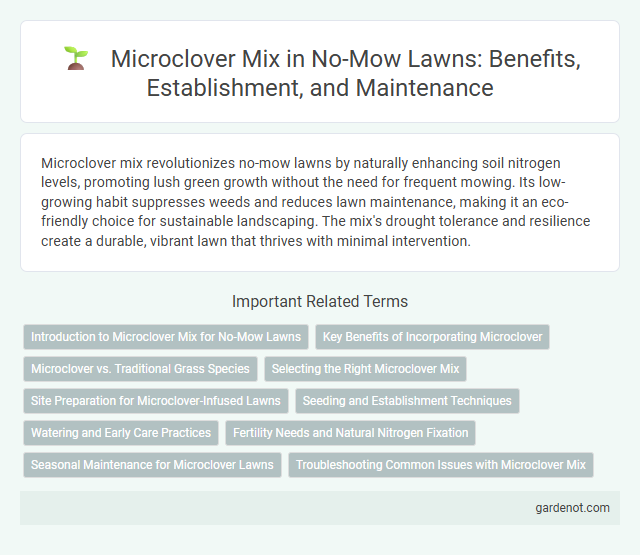Microclover mix revolutionizes no-mow lawns by naturally enhancing soil nitrogen levels, promoting lush green growth without the need for frequent mowing. Its low-growing habit suppresses weeds and reduces lawn maintenance, making it an eco-friendly choice for sustainable landscaping. The mix's drought tolerance and resilience create a durable, vibrant lawn that thrives with minimal intervention.
Introduction to Microclover Mix for No-Mow Lawns
Microclover mix enhances no-mow lawns by naturally fixing nitrogen, reducing the need for fertilizers and promoting lush, green grass coverage. Its dense growth helps suppress weeds and maintains a soft, low-maintenance turf that thrives with minimal mowing. Ideal for eco-friendly landscapes, microclover blends seamlessly with traditional grass, improving drought resistance and soil health.
Key Benefits of Incorporating Microclover
Incorporating microclover into a no-mow lawn enhances nitrogen fixation, reducing the need for synthetic fertilizers and promoting healthier grass growth. Its deep-root system improves drought resistance and soil structure, minimizing water usage and lawn maintenance. Microclover also increases lawn density, providing natural weed suppression and a lush, green appearance throughout the seasons.
Microclover vs. Traditional Grass Species
Microclover mix enhances no-mow lawns by fixing nitrogen naturally, reducing the need for synthetic fertilizers compared to traditional grass species like Kentucky bluegrass or fescue. Its dense, low-growing habit suppresses weeds and maintains green coverage with less water and mowing. Unlike conventional grasses, microclover is drought-tolerant and improves soil health, making it an eco-friendly choice for sustainable lawn care.
Selecting the Right Microclover Mix
Selecting the right microclover mix for a no-mow lawn involves choosing a blend with high-quality Trifolium repens varieties known for durability and adaptability to local climates. Opt for mixes that combine microclover with drought-resistant grass species to enhance lawn resilience and reduce maintenance needs. Ensuring the mix contains nitrogen-fixing microclover promotes natural soil fertilization, improving overall lawn health without frequent mowing.
Site Preparation for Microclover-Infused Lawns
Site preparation for microclover-infused lawns requires thorough soil testing to ensure adequate pH levels between 6.0 and 7.0 and balanced nutrient availability, promoting healthy microclover establishment. Proper soil aeration and removal of debris enhance seed-to-soil contact, crucial for microclover germination in no-mow lawn systems. Incorporating organic matter boosts soil structure and moisture retention, supporting resilient microclover growth and enhancing the overall sustainability of the no-mow lawn.
Seeding and Establishment Techniques
Microclover mix requires precise seeding techniques, ideally broadcast at a rate of 2-4 pounds per 1,000 square feet to ensure uniform coverage and optimal ground fixation. Incorporating light raking after seeding enhances soil contact, promoting faster germination within 7-14 days under ideal moisture conditions. Consistent moisture maintenance during establishment is critical to strengthen root development and achieve a resilient no-mow lawn.
Watering and Early Care Practices
Microclover mix requires consistent moisture during establishment, with daily watering recommended to keep the soil evenly moist but not waterlogged for the first two weeks. Early care practices include avoiding heavy foot traffic and mowing only after the microclover reaches about 3 inches in height to promote healthy root development. Proper watering and gentle maintenance enhance the drought tolerance and nitrogen-fixing benefits of a no-mow microclover lawn.
Fertility Needs and Natural Nitrogen Fixation
Microclover mix enhances no-mow lawn fertility by naturally fixing atmospheric nitrogen through symbiotic bacteria in its root nodules, reducing the need for synthetic fertilizers. This nitrogen fixation process improves soil health, promotes lush, green growth, and supports a sustainable, low-maintenance lawn ecosystem. Its ability to thrive in low-fertility soils makes microclover an ideal component for eco-friendly, nutrient-efficient no-mow lawn mixes.
Seasonal Maintenance for Microclover Lawns
Seasonal maintenance for microclover lawns involves adjusting mowing heights and frequency to promote dense growth and nitrogen fixation throughout the year. In spring, mow at 2 to 3 inches to encourage strong root development, while summer mowing should be slightly higher to reduce drought stress and protect the plant's nitrogen-fixing ability. Fall maintenance includes reducing mowing to improve turf density and preparing the microclover for winter dormancy, ensuring a healthier lawn come spring.
Troubleshooting Common Issues with Microclover Mix
Microclover mix may experience patchy growth due to inconsistent watering or poor soil drainage, which can be resolved by improving irrigation practices and aerating the soil. Yellowing leaves often indicate nutrient deficiencies, best addressed by applying a balanced, slow-release fertilizer rich in nitrogen. To prevent weed invasion in microclover lawns, regular mowing at the optimal height of 2 to 3 inches maintains turf density and reduces weed seed germination.
Microclover mix Infographic

 gardenot.com
gardenot.com